Vaheguroo Jee Kaa Khalsa Vaheguroo Jee Kee Fateh
there will be no futher entries on this blog in near future. I would recommend you visit the links on the right.
Forgive Daas for the numerous mistakes he has made and will continue to make...... Bhull Chuk Maff
Guroo Rakha
Vaheguroo Jee Kaa Khalsa Vaheguroo Jee Kee Fateh
Wednesday, September 14, 2005
Tuesday, September 13, 2005
Questions Answer
Quesions and Answers
“Is clapping allowed inside Darbaar Sahib, in the presence of Sri Guru Granth Sahib Ji?”
When we clap we are basically saying "this is from us to you, the performer (or whoever)". A Sikh expresses joy or appreciation of someone or something through praising Vaheguru. This is done through the Jaikaara, the Sikh slogan: “Bole So Nihaal, Sat Sri Akaal!” which translates to mean “Whosoever replies to this shall be blessed: “True is the Immortal Lord”” or “Whoever says, “True is the Immortal Lord” shall be blessed”.
When a jaikaara is uttered we are thanking Akaal Purakh, the All Knowing and Bestower of Gifts. Clapping is a sign of 'I agree with what you say'. This requires a two part agreement. Gurbaani on the other hand, does not take advice but only gives. Therefore, clapping inside darbaar sahib or in the Saadh-sangat is manmat, contrary to the Guru’s teachings.
In the Darbaar (court) of the Guru only ‘sach’, truth, is told, whether you like it or not. For Gursikhs, the Guru Darbaar is a place to take lessons from, and not to be on equal status or to agree with. It is a place to learn to be a slave. Therefore it is clear that clapping is not appropriate in these settings. For similar reasons clapping or applaud is prohibited inside a Church or Mosque, instead recognition or praise is expressed through saying “Amen” or “Glory be to God”.
“Someone told a friend of mine that it is okay for an Amritdhari to drink sharaab (liquor). However, you shouldn’t drink regularly or get drunk i.e. it is okay for an Amritdhari to drink socially once in a while. This baffled me. I knew it weren’t right but didn’t know enough to explain to my friend what is right.”
Section 4, Chapter X, Article XVI of the Panthic Sikh Rehat Maryada states:“(j) A Sikh must not take hemp (cannabis), opium, liquor, tobacco, in short any intoxicant. His only routine intake should be food.”
Please refer to Panthic Weekly’s “Understanding the Sikh Rehat Maryada” dated 4th September. That article discusses consuming liquor in regards to Gurmat.http://panthic.org/news/125/ARTICLE/1730/2005-09-04.html
“Who is a Sikh? I was confused after someone in a lecture implied that anyone and everyone is a Sikh, as long as you feel you are Sikh within. Though it seemed to make sense to an extent, I was unsure in regards to what the person meant in terms of being Keshdhari, and taking Amrit. Does a Sikh have to take Amrit or keep Kesh, or as open-minded caring people should we indiscriminately ‘appreciate’ and ‘rejoice’ the diversity of different types of Sikhs within our community.”
Please refer to an earlier article that issued on Panthic Weekly entitled: “Amrit – is it for everyone?”http://panthic.org/news/129/ARTICLE/1510/2005-07-10.html
Read this and more questions: http://www.panthic.org/news/130/ARTICLE/1771/2005-09-11.html
“Is clapping allowed inside Darbaar Sahib, in the presence of Sri Guru Granth Sahib Ji?”
When we clap we are basically saying "this is from us to you, the performer (or whoever)". A Sikh expresses joy or appreciation of someone or something through praising Vaheguru. This is done through the Jaikaara, the Sikh slogan: “Bole So Nihaal, Sat Sri Akaal!” which translates to mean “Whosoever replies to this shall be blessed: “True is the Immortal Lord”” or “Whoever says, “True is the Immortal Lord” shall be blessed”.
When a jaikaara is uttered we are thanking Akaal Purakh, the All Knowing and Bestower of Gifts. Clapping is a sign of 'I agree with what you say'. This requires a two part agreement. Gurbaani on the other hand, does not take advice but only gives. Therefore, clapping inside darbaar sahib or in the Saadh-sangat is manmat, contrary to the Guru’s teachings.
In the Darbaar (court) of the Guru only ‘sach’, truth, is told, whether you like it or not. For Gursikhs, the Guru Darbaar is a place to take lessons from, and not to be on equal status or to agree with. It is a place to learn to be a slave. Therefore it is clear that clapping is not appropriate in these settings. For similar reasons clapping or applaud is prohibited inside a Church or Mosque, instead recognition or praise is expressed through saying “Amen” or “Glory be to God”.
“Someone told a friend of mine that it is okay for an Amritdhari to drink sharaab (liquor). However, you shouldn’t drink regularly or get drunk i.e. it is okay for an Amritdhari to drink socially once in a while. This baffled me. I knew it weren’t right but didn’t know enough to explain to my friend what is right.”
Section 4, Chapter X, Article XVI of the Panthic Sikh Rehat Maryada states:“(j) A Sikh must not take hemp (cannabis), opium, liquor, tobacco, in short any intoxicant. His only routine intake should be food.”
Please refer to Panthic Weekly’s “Understanding the Sikh Rehat Maryada” dated 4th September. That article discusses consuming liquor in regards to Gurmat.http://panthic.org/news/125/ARTICLE/1730/2005-09-04.html
“Who is a Sikh? I was confused after someone in a lecture implied that anyone and everyone is a Sikh, as long as you feel you are Sikh within. Though it seemed to make sense to an extent, I was unsure in regards to what the person meant in terms of being Keshdhari, and taking Amrit. Does a Sikh have to take Amrit or keep Kesh, or as open-minded caring people should we indiscriminately ‘appreciate’ and ‘rejoice’ the diversity of different types of Sikhs within our community.”
Please refer to an earlier article that issued on Panthic Weekly entitled: “Amrit – is it for everyone?”http://panthic.org/news/129/ARTICLE/1510/2005-07-10.html
Read this and more questions: http://www.panthic.org/news/130/ARTICLE/1771/2005-09-11.html
Monday, September 12, 2005
I am a sacrifice to You
This Shabad is by Guru Arjan Dev Ji in Raag Tukhaari on Anng 1117
thukhaaree shha(n)th mehalaa 5
Tukhaari Chhant, Fifth Mehl:
ik oa(n)kaar sathigur prasaadh
One Universal Creator God. By The Grace Of The True Guru:
ghol ghumaaee laalanaa gur man dheenaa
O my Beloved, I am a sacrifice to You. Through the Guru, I have dedicated my mind to You.
sun sabadh thumaaraa maeraa man bheenaa
Hearing the Word of Your Shabad, my mind is enraptured.
eihu man bheenaa jio jal meenaa laagaa ra(n)g muraaraa
This mind is enraptured, like the fish in the water; it is lovingly attached to the Lord.
keemath kehee n jaaee t(h)aakur thaeraa mehal apaaraa
Your Worth cannot be described, O my Lord and Master; Your Mansion is Incomparable and Unrivalled.
sagal gunaa kae dhaathae suaamee bino sunahu eik dheenaa
O Giver of all Virtue, O my Lord and Master, please hear the prayer of this humble person.
dhaehu dharas naanak balihaaree jeearraa bal bal keenaa 1
Please bless Nanak with the Blessed Vision of Your Darshan. I am a sacrifice, my soul is a sacrifice, a sacrifice to You. 1
eihu than man thaeraa sabh gun thaerae
This body and mind are Yours; all virtues are Yours.
kha(n)neeai va(n)n(j)aa dharasan thaerae
I am a sacrifice, every little bit, to Your Darshan.
dharasan thaerae sun prabh maerae nimakh dhrisatt paekh jeevaa
Please hear me, O my Lord God; I live only by seeing Your Vision, even if only for an instant.
a(n)mrith naam suneejai thaeraa kirapaa karehi th peevaa
I have heard that Your Name is the most Ambrosial Nectar; please bless me with Your Mercy, that I may drink it in.
aas piaasee pir kai thaaee jio chaathrik boo(n)dhaerae
My hopes and desires rest in You, O my Husband Lord; like the rainbird, I long for the rain-drop.
kahu naanak jeearraa balihaaree dhaehu dharas prabh maerae 2
Says Nanak, my soul is a sacrifice to You; please bless me with Your Darshan, O my Lord God. 2
thoo saachaa saahib saahu amithaa
You are my True Lord and Master, O Infinite King.
thoo preetham piaaraa praan hith chithaa
You are my Dear Beloved, so dear to my life and consciousness.
praan sukhadhaathaa guramukh jaathaa sagal ra(n)g ban aaeae
You bring peace to my soul; You are known to the Gurmukh. All are blessed by Your Love.
soee karam kamaavai praanee jaehaa thoo furamaaeae
The mortal does only those deeds which You ordain, Lord.
jaa ko kirapaa karee jagadheesur thin saadhhasa(n)g man jithaa
One who is blessed by Your Grace, O Lord of the Universe, conquers his mind in the Saadh Sangat, the Company of the Holy.
kahu naanak jeearraa balihaaree jeeo pi(n)dd tho dhithaa 3
Says Nanak, my soul is a sacrifice to You; You gave me my soul and body. 3
niragun raakh leeaa sa(n)than kaa sadhakaa
I am unworthy, but He has saved me, for the sake of the Saints.
sathigur dtaak leeaa mohi paapee parradhaa
The True Guru has covered by faults; I am such a sinner.
dtaakanehaarae prabhoo hamaarae jeea praan sukhadhaathae
God has covered for me; He is the Giver of the soul, life and peace.
abinaasee abigath suaamee pooran purakh bidhhaathae
My Lord and Master is Eternal and Unchanging, Ever-present; He is the Perfect Creator, the Architect of Destiny.
ousathath kehan n jaae thumaaree koun kehai thoo kadh kaa
Your Praise cannot be described; who can say where You are?
naanak dhaas thaa kai balihaaree milai naam har nimakaa 4111
Slave Nanak is a sacrifice to the one who blesses him with the Lord's Name, even for an instant. 4111
Gurmukhi
Audio:
Bhai Nirmal Singh Jee Khalsa
Bhai Sarabjit Singh Rangila
Bhai Surinder Singh Jodhpuri
Bhai Amrik Singh Zakhmi
thukhaaree shha(n)th mehalaa 5
Tukhaari Chhant, Fifth Mehl:
ik oa(n)kaar sathigur prasaadh
One Universal Creator God. By The Grace Of The True Guru:
ghol ghumaaee laalanaa gur man dheenaa
O my Beloved, I am a sacrifice to You. Through the Guru, I have dedicated my mind to You.
sun sabadh thumaaraa maeraa man bheenaa
Hearing the Word of Your Shabad, my mind is enraptured.
eihu man bheenaa jio jal meenaa laagaa ra(n)g muraaraa
This mind is enraptured, like the fish in the water; it is lovingly attached to the Lord.
keemath kehee n jaaee t(h)aakur thaeraa mehal apaaraa
Your Worth cannot be described, O my Lord and Master; Your Mansion is Incomparable and Unrivalled.
sagal gunaa kae dhaathae suaamee bino sunahu eik dheenaa
O Giver of all Virtue, O my Lord and Master, please hear the prayer of this humble person.
dhaehu dharas naanak balihaaree jeearraa bal bal keenaa 1
Please bless Nanak with the Blessed Vision of Your Darshan. I am a sacrifice, my soul is a sacrifice, a sacrifice to You. 1
eihu than man thaeraa sabh gun thaerae
This body and mind are Yours; all virtues are Yours.
kha(n)neeai va(n)n(j)aa dharasan thaerae
I am a sacrifice, every little bit, to Your Darshan.
dharasan thaerae sun prabh maerae nimakh dhrisatt paekh jeevaa
Please hear me, O my Lord God; I live only by seeing Your Vision, even if only for an instant.
a(n)mrith naam suneejai thaeraa kirapaa karehi th peevaa
I have heard that Your Name is the most Ambrosial Nectar; please bless me with Your Mercy, that I may drink it in.
aas piaasee pir kai thaaee jio chaathrik boo(n)dhaerae
My hopes and desires rest in You, O my Husband Lord; like the rainbird, I long for the rain-drop.
kahu naanak jeearraa balihaaree dhaehu dharas prabh maerae 2
Says Nanak, my soul is a sacrifice to You; please bless me with Your Darshan, O my Lord God. 2
thoo saachaa saahib saahu amithaa
You are my True Lord and Master, O Infinite King.
thoo preetham piaaraa praan hith chithaa
You are my Dear Beloved, so dear to my life and consciousness.
praan sukhadhaathaa guramukh jaathaa sagal ra(n)g ban aaeae
You bring peace to my soul; You are known to the Gurmukh. All are blessed by Your Love.
soee karam kamaavai praanee jaehaa thoo furamaaeae
The mortal does only those deeds which You ordain, Lord.
jaa ko kirapaa karee jagadheesur thin saadhhasa(n)g man jithaa
One who is blessed by Your Grace, O Lord of the Universe, conquers his mind in the Saadh Sangat, the Company of the Holy.
kahu naanak jeearraa balihaaree jeeo pi(n)dd tho dhithaa 3
Says Nanak, my soul is a sacrifice to You; You gave me my soul and body. 3
niragun raakh leeaa sa(n)than kaa sadhakaa
I am unworthy, but He has saved me, for the sake of the Saints.
sathigur dtaak leeaa mohi paapee parradhaa
The True Guru has covered by faults; I am such a sinner.
dtaakanehaarae prabhoo hamaarae jeea praan sukhadhaathae
God has covered for me; He is the Giver of the soul, life and peace.
abinaasee abigath suaamee pooran purakh bidhhaathae
My Lord and Master is Eternal and Unchanging, Ever-present; He is the Perfect Creator, the Architect of Destiny.
ousathath kehan n jaae thumaaree koun kehai thoo kadh kaa
Your Praise cannot be described; who can say where You are?
naanak dhaas thaa kai balihaaree milai naam har nimakaa 4111
Slave Nanak is a sacrifice to the one who blesses him with the Lord's Name, even for an instant. 4111
Gurmukhi
Audio:
Bhai Nirmal Singh Jee Khalsa
Bhai Sarabjit Singh Rangila
Bhai Surinder Singh Jodhpuri
Bhai Amrik Singh Zakhmi
Thursday, September 08, 2005
Distroying Sorrow
This Shabad is by Guru Arjan Dev Ji in Raag Gauree on Anng 218
gourree mehalaa 5 maa(n)jh
Gauree, Fifth Mehl, Maajh:
dhukh bha(n)jan thaeraa naam jee dhukh bha(n)jan thaeraa naam
The Destroyer of sorrow is Your Name, Lord; the Destroyer of sorrow is Your Name.
aat(h) pehar aaraadhheeai pooran sathigur giaan 1 rehaao
Twenty-four hours a day, dwell upon the wisdom of the Perfect True Guru. 1Pause
jith ghatt vasai paarabreham soee suhaavaa thhaao
That heart, in which the Supreme Lord God abides, is the most beautiful place.
jam ka(n)kar naerr n aavee rasanaa har gun gaao 1
The Messenger of Death does not even approach those who chant the Glorious Praises of the Lord with the tongue. 1
saevaa surath n jaaneeaa naa jaapai aaraadhh
I have not understood the wisdom of serving Him, nor have I worshipped Him in meditation.
outt thaeree jagajeevanaa maerae t(h)aakur agam agaadhh 2
You are my Support, O Life of the World; O my Lord and Master, Inaccessible and Incomprehensible. 2
bheae kirapaal gusaaeeaa nat(h)ae sog sa(n)thaap
When the Lord of the Universe became merciful, sorrow and suffering departed.
thathee vaao n lagee sathigur rakhae aap 3
The hot winds do not even touch those who are protected by the True Guru. 3
gur naaraaein dhay gur gur sachaa sirajanehaar
The Guru is the All-pervading Lord, the Guru is the Merciful Master; the Guru is the True Creator Lord.
gur thut(h)ai sabh kishh paaeiaa jan naanak sadh balihaar 42170
When the Guru was totally satisfied, I obtained everything. Servant Nanak is forever a sacrifice to Him. 42170
Gurmukhi, STTM
Audio:
gourree mehalaa 5 maa(n)jh
Gauree, Fifth Mehl, Maajh:
dhukh bha(n)jan thaeraa naam jee dhukh bha(n)jan thaeraa naam
The Destroyer of sorrow is Your Name, Lord; the Destroyer of sorrow is Your Name.
aat(h) pehar aaraadhheeai pooran sathigur giaan 1 rehaao
Twenty-four hours a day, dwell upon the wisdom of the Perfect True Guru. 1Pause
jith ghatt vasai paarabreham soee suhaavaa thhaao
That heart, in which the Supreme Lord God abides, is the most beautiful place.
jam ka(n)kar naerr n aavee rasanaa har gun gaao 1
The Messenger of Death does not even approach those who chant the Glorious Praises of the Lord with the tongue. 1
saevaa surath n jaaneeaa naa jaapai aaraadhh
I have not understood the wisdom of serving Him, nor have I worshipped Him in meditation.
outt thaeree jagajeevanaa maerae t(h)aakur agam agaadhh 2
You are my Support, O Life of the World; O my Lord and Master, Inaccessible and Incomprehensible. 2
bheae kirapaal gusaaeeaa nat(h)ae sog sa(n)thaap
When the Lord of the Universe became merciful, sorrow and suffering departed.
thathee vaao n lagee sathigur rakhae aap 3
The hot winds do not even touch those who are protected by the True Guru. 3
gur naaraaein dhay gur gur sachaa sirajanehaar
The Guru is the All-pervading Lord, the Guru is the Merciful Master; the Guru is the True Creator Lord.
gur thut(h)ai sabh kishh paaeiaa jan naanak sadh balihaar 42170
When the Guru was totally satisfied, I obtained everything. Servant Nanak is forever a sacrifice to Him. 42170
Gurmukhi, STTM
Audio:
Monday, September 05, 2005
Hey Waheguruu Jee
Putting life in to Prospectus when your feeling the blues.
Today, upon a bus, I saw a girl with golden hair. and wished I was as fair. When suddenly she rose to leave, I saw her hobble down the aisle. She had one leg and wore a crutch. But as she passed, a smile. Hey Waheguruji, forgive me when I whine. I have 2 legs, the world is mine.
I stopped to buy some candy. The lad who sold it had such charm. I talked with him, he seemed so glad. If I were late, it'd do no harm. And as I left, he said to me, "I thank you, you've been so kind. It's nice to talk with folks like you. You see," he said, "I'm blind." Hey Waheguruji, forgive me when I whine. I have 2 eyes, the world is mine.
Later while walking down the street, I saw a child with eyes of blue. He stood and watched the others play. He did not know what to do. I stopped a moment and then I said, "Why don't you join the others, dear?" He looked ahead without a word. And then I knew, he couldn't hear. Hey Waheguruji, forgive me when I whine. I have 2 ears, the world is mine.
With feet to take me where I'd go. With eyes to see the sunset's glow. With ears to hear what I'd know. Hey Waheguruji, forgive me when I whine. I've been blessed indeed, the world is mine
Business is Business
One day at school a teacher said to the class of5-year-olds, "I'll give £2 to the child who can tell me who was the mostfamous man who ever lived."
An Irish boy put his hand up and said, "It wasSt.Patrick." The teacher said, "Sorry Sean, that's not correct."
Then a Scottish boy put his hand up and said, "Itwas St. Andrew." The teacher replied, "I'm sorry, Hamish, that's not righteither.
Finally, a sikh boy raised his hand and said, "Itwas Jesus Christ." The teacher said, "That's absolutely right, Baljit, comeup here and I'll give you the £2."
As the teacher was giving Baljit his money, she said,"You know Baljit, since you're sikh, I was very surprised you said JesusChrist."
Baljit replied, "Yeah. In my heart I knew it wasGuru Nanak, but business is business!"
An Irish boy put his hand up and said, "It wasSt.Patrick." The teacher said, "Sorry Sean, that's not correct."
Then a Scottish boy put his hand up and said, "Itwas St. Andrew." The teacher replied, "I'm sorry, Hamish, that's not righteither.
Finally, a sikh boy raised his hand and said, "Itwas Jesus Christ." The teacher said, "That's absolutely right, Baljit, comeup here and I'll give you the £2."
As the teacher was giving Baljit his money, she said,"You know Baljit, since you're sikh, I was very surprised you said JesusChrist."
Baljit replied, "Yeah. In my heart I knew it wasGuru Nanak, but business is business!"
Friday, September 02, 2005
Gurmat Sangeet - Sikh Musical Instruments
The Sikh nation has many instruments which where played during and by the ten Sikh guru's and have recently begun to disappear. Unfortunately there is very little knowledge today of these instruments and what they look like let alone knowledge of Raag. Guruu Granth Sahib Jee is set out in Raags which each shabad to be sung in a certain mood/raag. The following are small desertions of Sikh Musical instruments accompanied by a photograph.
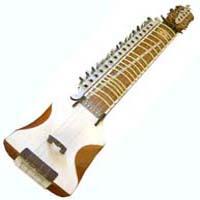
DILRUBA
The Taus, a failrly large and heavy instrument, was designed and created by the tenth Sikh Guru, Gobind Singh. The Sikhs approached Guru Gobind Singh and suggested that its size and weight can create a prob lem in mobility for the Saint-Warriors. Upon request the Guru gave the Sikhs permission to scale down the size and design of the taus. The resulting instrument came in the shape of what is now known as the dilruba (a Persian word meaning ‘heart stealer’).
Early instruments were decorated with gildwork and the gaj bore two or three tassles, usually red or green, on one or both ends. These instruments have a subtle, majestic look.
The dilruba is one of the most popular stringed instruments in the North of India and, like the taus, is a clever combination of the sitar and the sarangi. The fingerboard with the frets very much resembles the sitar. The belly of the instrument is covered with skin like a Sarangi and, like the Sarangi and Taus, it is played with a bow (gaj). The main difference from the Taus is the lack of the artistic peacock head and design of the body.
The stem of the dilruba contains eighteen or nineteen elliptical frets which are movable. They are tied to the stem by means of thin pieces of gut so that the frets can be moved according to the scale of the raga being played. The bridge is placed on the skin-covered body, over which all the main and sympathetic strings pass. Of the four main strings, the last is the principal playing string. There are about twenty-two sympathetic strings or tarabs running underneath the frets and fastened to a series of pegs on the side.
The bowing is done with the right hand while the fingers of the left hand are used to play over the strings. The frets on the dilruba are meant only to guide the player in locating the correct position of the notes. The dilruba is held vertically, the lower portion on the lap of the performer or in front of him and the top resting against the left shoulder.
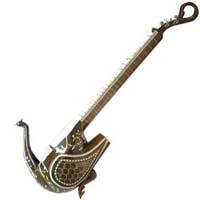
Taus
Taus means ‘peacock’ in Persian and is derived from sitar and sarangi. It’s body is shaped like a peacock and it is played with a bow. It has a sound hole at the ‘tail’ portion of the instrument and stands on bird-feet carved in wood.
Guru Gobind Singh Ji, the tenth Guru of Sikhs, kept the family trend by creating the instrument which he named the ‘taus’, which, in Persian, means peacock. Some scholars believe that the sitar was invented in Guru Gobind Singh’s time period as well, and that the creation of new instruments was in fashion at that time. The taus is painted in all of the bright shades of the beautiful bird, the peacock, in its sound structure. Its long tail serves the purpose of the finger board of the instrument, upon which nineteen metal frets, elliptical in shape, are tied with cotton or silken cord. The lower portion, the head, carved to look just like the peacock, is covered with hide. The taus is played seated, with a bow. The parts of the bow include a wooden round stick, bow hair of horse tail, a wooden bridge, and a screw. The taus has sixteen sympathetic metal strings, along with its four playing strings.
The taus is very similar to the dilruba in construction and in playing technique. However, the taus has a bigger sound box and therefore produces a much more resonant and mellow sound.
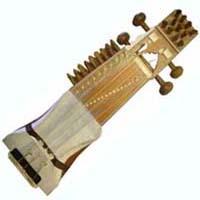
Sarangi
The name Sarangi is said to mean ‘sau rang’ (100 colours) or ‘sa rang’ (colours whatever it touches). It is the most important bowed instrument of North Indian music.
Like most stringed instruments the sarangi has a wooden sound box. The instrument has no frets or fingerboard; the strings float in the air. Pitch is determined by sliding the fingernail against the string rather than pressing it against a fingerboard (like violin). This allows subtle glides and embellishments, which are extremely close to the human voice.
The Sarangi of the Sikhs was brought in and promoted by the sixth Guru, Hargobind Sahib, to sing the ballads from Siri Guru Granth Sahib or from Bhai Guru Das’ poetry. Vaaran (ballads) are to be found in great number among these works, and they incorporate an aggressive approach to singing and expression (an attack on the mind).
It appears that the Sarangi was a folk instrument long before it came to be accepted in classical music as an accompanying instrument. This was most probably during the rise of the Khayal gayaki (style) at the time of Mohammed Shah ‘Rangila’. By the nineteenth century, the Sarangi came to be associated with dancing girls and courtesans, and was used as the standard instrument for accompanying Khayal, Thumri, and occasionally for Dhrupad. However, its popularity is on the decline, partly because of these negative associations, and partly because of the technical difficulties in tuning and playing the instrument.
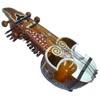
Saranda
Guru Arjan Dev (1563-1606), fifth Sikh Guru, was a master musician and musicologist. He had a great passion for folk music, and looking at his contribution to the musical heritage of India, we see a huge line up which is influenced by folk traditions.
The Saranda took birth from his passion for music. However, there are varying statements and opinions by scholars as to who actually created th e Saranda. Some say it was the idea of Guru Angad Dev Ji and was developed by Guru Ramdas Sahib, the fourth Guru. Examining the facts concerning that time period, and the musical interests related to that period, it makes more sense to believe that Guru Arjan Dev ji invented, or developed, the Saranda. He is said to have designed the Saranda (a large bowl-shaped string instrument, played with bow), which he himself played and used as the ideal accompaniment for the male voice.
The Saranda produces a hauntingly beautiful deep tone quality which sings in alternation and in support of the human voice.
Other instruments:

Pakhawaj
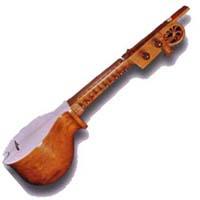
Rabaab
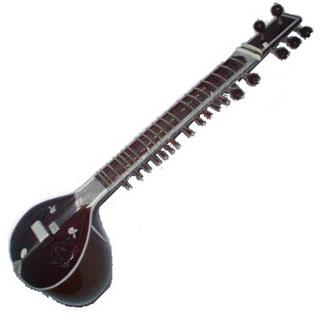
Sitar
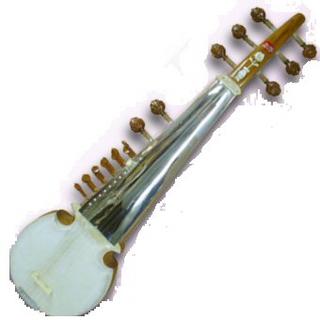
Sarode
Other instruments include: Santoor, Tabla, Tanpura

DILRUBA
The Taus, a failrly large and heavy instrument, was designed and created by the tenth Sikh Guru, Gobind Singh. The Sikhs approached Guru Gobind Singh and suggested that its size and weight can create a prob lem in mobility for the Saint-Warriors. Upon request the Guru gave the Sikhs permission to scale down the size and design of the taus. The resulting instrument came in the shape of what is now known as the dilruba (a Persian word meaning ‘heart stealer’).
Early instruments were decorated with gildwork and the gaj bore two or three tassles, usually red or green, on one or both ends. These instruments have a subtle, majestic look.
The dilruba is one of the most popular stringed instruments in the North of India and, like the taus, is a clever combination of the sitar and the sarangi. The fingerboard with the frets very much resembles the sitar. The belly of the instrument is covered with skin like a Sarangi and, like the Sarangi and Taus, it is played with a bow (gaj). The main difference from the Taus is the lack of the artistic peacock head and design of the body.
The stem of the dilruba contains eighteen or nineteen elliptical frets which are movable. They are tied to the stem by means of thin pieces of gut so that the frets can be moved according to the scale of the raga being played. The bridge is placed on the skin-covered body, over which all the main and sympathetic strings pass. Of the four main strings, the last is the principal playing string. There are about twenty-two sympathetic strings or tarabs running underneath the frets and fastened to a series of pegs on the side.
The bowing is done with the right hand while the fingers of the left hand are used to play over the strings. The frets on the dilruba are meant only to guide the player in locating the correct position of the notes. The dilruba is held vertically, the lower portion on the lap of the performer or in front of him and the top resting against the left shoulder.

Taus
Taus means ‘peacock’ in Persian and is derived from sitar and sarangi. It’s body is shaped like a peacock and it is played with a bow. It has a sound hole at the ‘tail’ portion of the instrument and stands on bird-feet carved in wood.
Guru Gobind Singh Ji, the tenth Guru of Sikhs, kept the family trend by creating the instrument which he named the ‘taus’, which, in Persian, means peacock. Some scholars believe that the sitar was invented in Guru Gobind Singh’s time period as well, and that the creation of new instruments was in fashion at that time. The taus is painted in all of the bright shades of the beautiful bird, the peacock, in its sound structure. Its long tail serves the purpose of the finger board of the instrument, upon which nineteen metal frets, elliptical in shape, are tied with cotton or silken cord. The lower portion, the head, carved to look just like the peacock, is covered with hide. The taus is played seated, with a bow. The parts of the bow include a wooden round stick, bow hair of horse tail, a wooden bridge, and a screw. The taus has sixteen sympathetic metal strings, along with its four playing strings.
The taus is very similar to the dilruba in construction and in playing technique. However, the taus has a bigger sound box and therefore produces a much more resonant and mellow sound.

Sarangi
The name Sarangi is said to mean ‘sau rang’ (100 colours) or ‘sa rang’ (colours whatever it touches). It is the most important bowed instrument of North Indian music.
Like most stringed instruments the sarangi has a wooden sound box. The instrument has no frets or fingerboard; the strings float in the air. Pitch is determined by sliding the fingernail against the string rather than pressing it against a fingerboard (like violin). This allows subtle glides and embellishments, which are extremely close to the human voice.
The Sarangi of the Sikhs was brought in and promoted by the sixth Guru, Hargobind Sahib, to sing the ballads from Siri Guru Granth Sahib or from Bhai Guru Das’ poetry. Vaaran (ballads) are to be found in great number among these works, and they incorporate an aggressive approach to singing and expression (an attack on the mind).
It appears that the Sarangi was a folk instrument long before it came to be accepted in classical music as an accompanying instrument. This was most probably during the rise of the Khayal gayaki (style) at the time of Mohammed Shah ‘Rangila’. By the nineteenth century, the Sarangi came to be associated with dancing girls and courtesans, and was used as the standard instrument for accompanying Khayal, Thumri, and occasionally for Dhrupad. However, its popularity is on the decline, partly because of these negative associations, and partly because of the technical difficulties in tuning and playing the instrument.

Saranda
Guru Arjan Dev (1563-1606), fifth Sikh Guru, was a master musician and musicologist. He had a great passion for folk music, and looking at his contribution to the musical heritage of India, we see a huge line up which is influenced by folk traditions.
The Saranda took birth from his passion for music. However, there are varying statements and opinions by scholars as to who actually created th e Saranda. Some say it was the idea of Guru Angad Dev Ji and was developed by Guru Ramdas Sahib, the fourth Guru. Examining the facts concerning that time period, and the musical interests related to that period, it makes more sense to believe that Guru Arjan Dev ji invented, or developed, the Saranda. He is said to have designed the Saranda (a large bowl-shaped string instrument, played with bow), which he himself played and used as the ideal accompaniment for the male voice.
The Saranda produces a hauntingly beautiful deep tone quality which sings in alternation and in support of the human voice.
Other instruments:

Pakhawaj

Rabaab

Sitar

Sarode
Other instruments include: Santoor, Tabla, Tanpura
Subscribe to:
Posts (Atom)